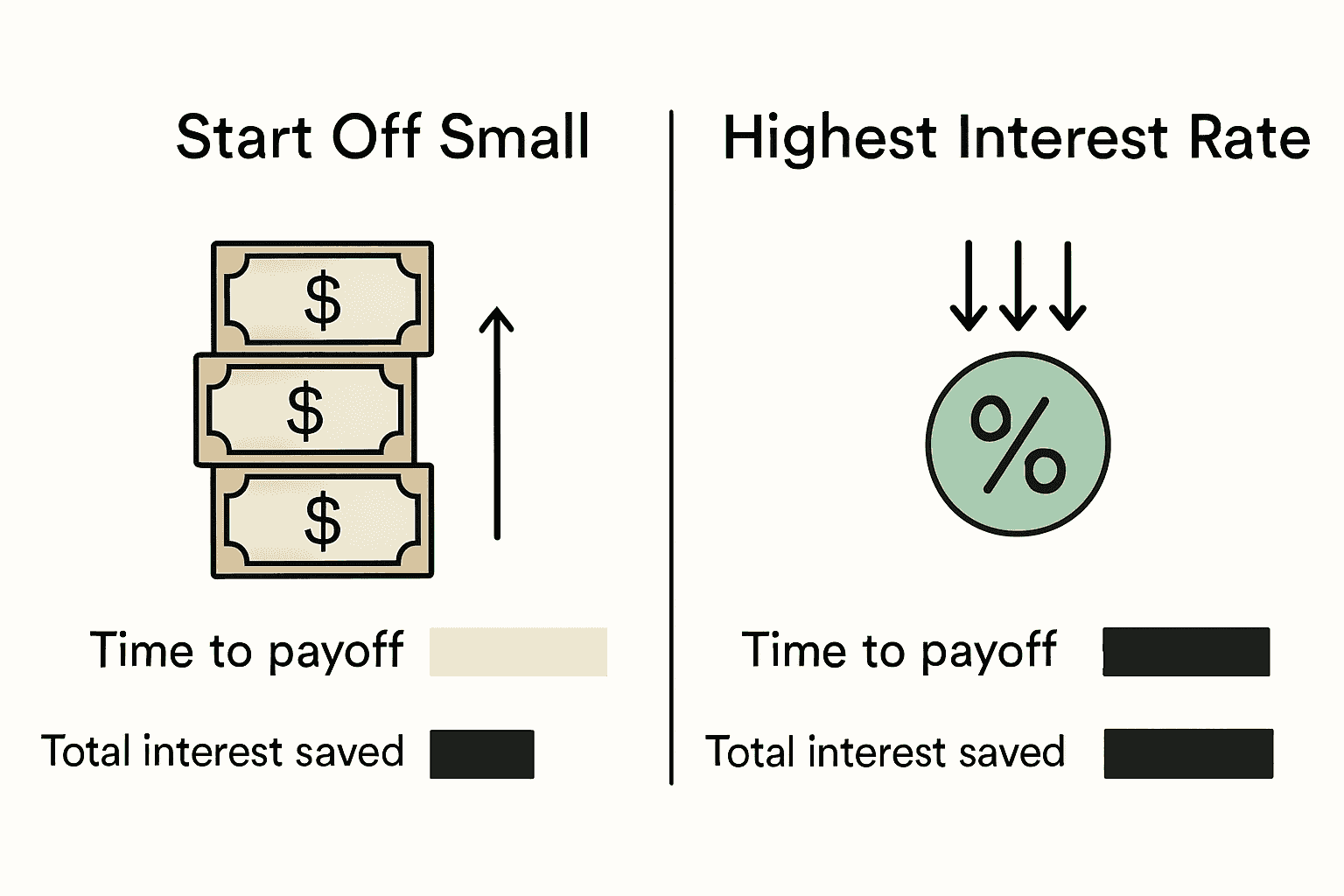Nearly 80 percent of adults carry some form of debt, and many feel trapped by monthly payments that never seem to shrink. Getting out of debt starts with a clear understanding of exactly what you owe and a solid plan to pay it off. By following a strategic approach, you can build momentum, reduce stress, and finally gain control of your finances without feeling lost or overwhelmed.
Table of Contents
- Step 1: Assess All Outstanding Debts Accurately
- Step 2: Set Clear and Achievable Repayment Goals
- Step 3: Select the Optimal Debt Repayment Strategy
- Step 4: Implement a Personalized Repayment Schedule
- Step 5: Monitor Progress and Adjust Tactics Regularly
Quick Summary
| Key Point | Explanation |
|---|---|
| 1. Assess all outstanding debts thoroughly | Collect detailed information on your debts, including balances, interest rates, and payments to develop a clear financial picture. |
| 2. Set SMART repayment goals | Create specific, measurable, achievable, relevant, and time-bound targets to help track your debt reduction progress effectively. |
| 3. Choose the best repayment strategy | Select between paying off the smallest debts first or targeting the highest interest rates to optimize your financial recovery. |
| 4. Create a personalized repayment schedule | Develop a budget that prioritizes debt repayment while accommodating essential living expenses and emergency savings. |
| 5. Regularly monitor and adjust your progress | Conduct monthly reviews of your repayments to stay on track and adapt your strategies based on changing financial circumstances. |
Step 1: Assess All Outstanding Debts Accurately
Your journey toward financial freedom begins with knowing exactly what you owe. According to Skills for Africa, a comprehensive debt assessment requires gathering detailed information about all outstanding financial obligations.
Start by collecting critical documentation for every debt you have credit card statements, loan agreements, medical bills, personal loans, student loans, and any other financial commitments. Create a master spreadsheet listing each debt with precise details including current balance, interest rate, minimum monthly payment, and total outstanding amount. Skills for Africa recommends calculating your debt-to-income ratio as a key metric to understand your overall financial health. This means dividing your total monthly debt payments by your gross monthly income.
Pro tip: Pull a recent credit report to ensure you haven’t missed any accounts. Some debts might have slipped under your radar or been forgotten. By obtaining an accurate snapshot of your complete financial landscape, you’ll be equipped to develop a strategic repayment plan that systematically reduces your debt burden.


Step 2: Set Clear and Achievable Repayment Goals
Now that you have a comprehensive view of your debts, it is time to transform your financial recovery into a strategic plan. According to NW District, setting effective debt management goals requires following the SMART framework Specific, Measurable, Achievable, Relevant, and Time-bound.
Begin by establishing precise debt reduction targets. Instead of a vague goal like “pay off debt,” create a concrete objective such as “reduce credit card debt by $5,000 within 12 months” or “eliminate student loan balance by end of next year.” Welcome Home Vets of NJ recommends breaking down larger financial objectives into actionable milestones. This approach transforms overwhelming financial challenges into manageable steps, significantly increasing your likelihood of success.
Pro tip: Combine your repayment goals with the master managing credit card debt guide to develop a comprehensive strategy. Track your progress monthly, celebrate small victories, and remain flexible. Your goals might need adjusting as your financial situation evolves, but maintaining consistent focus will drive you toward ultimate financial freedom.
Step 3: Select the Optimal Debt Repayment Strategy
Choosing the right debt repayment strategy can make a significant difference in your journey toward financial freedom. According to Consumer Finance, there are multiple approaches to tackling debt, each with unique advantages depending on your financial situation.
Two primary strategies emerge as powerful options. The first is the “Start Off Small” method, which focuses on paying off your smallest debts first. This approach provides psychological wins and momentum by helping you eliminate entire debt accounts quickly. The alternative is the “Highest Interest Rate” method, where you target debts with the most expensive interest rates to minimize long term financial drain. Consumer Finance recommends analyzing your personal financial landscape to determine which strategy aligns best with your goals.
Pro tip: Consider supplementing your debt strategy with insights from our managing student loan debt guide to create a comprehensive plan. Whichever method you choose, consistency and commitment are key.
Regular payments, even if small, will gradually chip away at your debt and bring you closer to financial liberation.


Step 4: Implement a Personalized Repayment Schedule
Creating a personalized repayment schedule transforms your debt reduction strategy from a theoretical concept into a practical action plan. According to AB Academies, effective budgeting requires carefully monitoring spending patterns and allocating funds strategically to prioritize debt repayment.
Start by mapping out your monthly income and expenses. Identify discretionary spending areas where you can redirect funds toward debt elimination. Calculate the maximum amount you can consistently allocate to debt repayment without compromising essential living expenses. AB Academies recommends creating a flexible budget that allows for emergency savings while systematically reducing your debt burden. This might mean cutting unnecessary subscriptions, reducing dining out, or finding more cost effective alternatives for regular expenses.
Pro tip: Complement your repayment schedule by reviewing our guide on budgeting effectively to optimize your financial planning. Set up automatic payments to ensure consistency and consider any potential windfalls like tax returns or bonuses as opportunities to make substantial debt reduction payments. Remember that your repayment schedule is a living document that can be adjusted as your financial situation evolves.
Step 5: Monitor Progress and Adjust Tactics Regularly
Successful debt management requires continuous evaluation and strategic adaptation. World Bank emphasizes the critical importance of regular monitoring and auditing your debt reduction progress to ensure you remain on track toward financial freedom.
Implement a monthly review process where you carefully assess your debt repayment performance. Compare your actual payments against your planned schedule, tracking total debt reduction, interest saved, and consistency of contributions. IMF recommends maintaining transparency in your financial operations by documenting each adjustment and understanding the reasoning behind your strategic changes. This might involve recalculating your debt payoff timeline, identifying unexpected expenses, or recognizing opportunities to accelerate your repayment strategy.
Pro tip: Consider creating a visual tracking system like a spreadsheet or debt reduction chart to maintain motivation. Celebrate small victories and be prepared to pivot your approach if certain tactics are not producing the desired results. Your commitment to consistent monitoring will transform your debt repayment from a passive process to an active financial strategy.
Take Control of Your Debt and Start Your Journey to Financial Freedom Today
Struggling with overwhelming debt can feel isolating and stressful. This article highlights the importance of assessing your total debt, setting clear repayment goals, and choosing the right strategies that fit your unique situation. If you are ready to move beyond just planning and want expert guidance to build a personalized, effective repayment schedule you can trust, we can help.
At finblog.com, we specialize in providing actionable financial advice designed for people committed to overcoming debt challenges. Explore our resources on managing credit card debt and student loan strategies to complement your debt reduction plan. Don’t wait for financial freedom to find you. Visit finblog.com now and take the first step toward a debt-free future with confidence.
Frequently Asked Questions
How do I accurately assess all my outstanding debts?
To assess all your outstanding debts accurately, collect documentation for each debt such as credit card statements, loan agreements, and medical bills. Create a master spreadsheet listing each debt with details like current balance and interest rate to get a complete picture of your financial obligations.
What are SMART goals, and how can I use them for debt repayment?
SMART goals are Specific, Measurable, Achievable, Relevant, and Time-bound objectives that help guide your debt repayment. For example, instead of saying “I want to pay off debt,” you could set a goal to “reduce credit card debt by $5,000 within 12 months” to create a clear path forward.
What are the most effective debt repayment strategies I should consider?
Two effective debt repayment strategies are the “Start Off Small” method, where you pay off your smallest debts first, and the “Highest Interest Rate” method, which targets debts with the highest interest rates. Choose a method that aligns with your financial situation to maximize your repayment efficiency.
How can I create a personalized repayment schedule?
To create a personalized repayment schedule, begin by mapping out your monthly income and expenses, identifying areas where you can cut discretionary spending. Allocate a specific amount each month towards debt repayment to ensure consistency and track your progress.
How often should I monitor my debt repayment progress?
You should monitor your debt repayment progress monthly to assess your performance against your planned schedule. This allows you to track total debt reduction and make necessary adjustments to stay on track toward achieving financial freedom.
What should I do if my debt repayment strategy isn’t working?
If your debt repayment strategy isn’t working, be prepared to pivot and try a different approach. Review your total debt, evaluate your current payment plan, and consider adjusting your repayment goals to refocus on manageable targets.
Recommended
- Master Managing Credit Card Debt: Achieve Financial Freedom – Finblog
- Effective Financial Stress Management for a Secure Future – Finblog
- Mastering Managing Student Loan Debt for Financial Success – Finblog
- How to Manage Debt: Proven Steps for Financial Freedom – Finblog
- Comment rembourser un crédit rapidement : stratégies
- How to Use Your Estate Plan to Protect a Child Who Has Addiction or Debt Problems – Law Office of Eric Ridley










